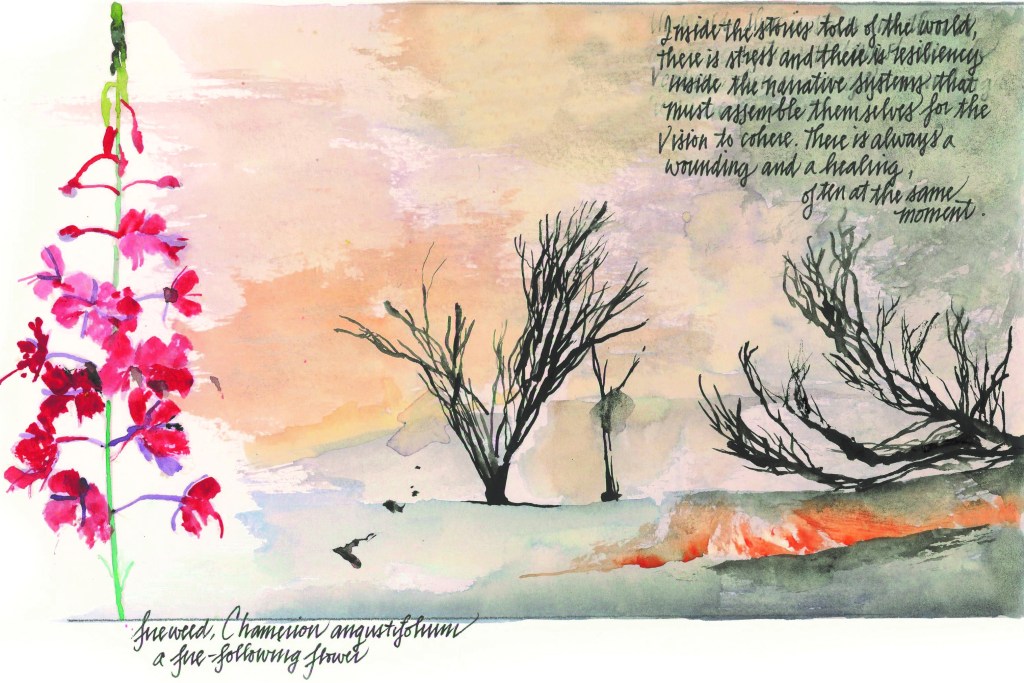Understanding California’s Relationship with Fire: Insights from Obi Kaufmann
In his recent work, “The State of Fire: Why California Burns,” author, illustrator, and naturalist Obi Kaufmann enlightens readers on the complex dynamics between humanity and fire. Published by Heyday in Berkeley, this compact yet expansive 240-page atlas meticulously examines fire’s historical significance, ecological roles, and underlying principles.
The Structure of Knowledge
Kaufmann’s book is thoughtfully arranged into three main sections that delve into fire’s past, its ecological impact, and fundamental principles. Each piece combines scientific insights with personal narratives drawn from Kaufmann’s extensive experience in California’s backcountry. His beautiful watercolor maps and artwork enhance the reader’s understanding of these themes.
Throughout the narrative arc—from indigenous knowledge of land management to the destructive interventions seen during human expansion—the text transforms a seemingly dire situation into one filled with hope for healing through conscientious stewardship. Rather than conveying guilt regarding environmental destruction, Kaufmann positions fire as a necessary element for revitalization.
Revolutionary Observations on Biodiversity
Having previously authored several atlases—including his acclaimed work “The California Field Atlas”—Kaufmann builds upon his reputation using this new volume to challenge conventional perceptions about fire. He argues that rather than being seen solely as destructive forces threatening landscapes—wildfires are essential nutrients that foster biodiversity in ecosystems.
He explains that research into California’s unique fire ecology reveals a history where indigenous practices over millennia have contributed significantly to modern biodiversity configurations. “Indigenous management techniques involving controlled burns have coexisted harmoniously with natural stressors,” he states. This interplay has enabled ecosystems to thrive against changing conditions—a paradigm shift necessary for current restoration efforts.
The Dangers of Exclusion Policies
Kaufmann emphasizes that policies aimed at excluding wildfires have resulted in older environments burdened by dying trees rather than creating safer spaces. “California burns not due to an excess of trees but because societal choices regarding ‘fire droughts’ hinder proper ecosystem management,” he asserts robustly.
The discussion extends to our interconnected existence within ecosystems—highlighting how human activities shape what is considered ‘natural’ or ‘wild.’ With our species dramatically affecting planetary systems over millions of years, it becomes clear we cannot detach ourselves from nature; doing so only jeopardizes our survival.
Embracing Fire through Informed Strategies
It is clear from Kaufmann’s examination that accepting fire as an integral part of Californian life is crucial moving forward. He advocates for deeply rooted partnerships with indigenous communities who possess sophisticated methodologies honed over centuries—even while recognizing the significant cultural shifts required across various sectors like tech innovation or conservation efforts.
Feral fires, a term highlighted in the book based on work by Professor Stephen Pyne from Arizona State University distinguish between chaotic fires stripped of cultural context versus intentional control measures meant for landscape preservation—reinforcing concerns around mismanaged wildfires erupting unexpectedly due to neglectful oversight.
A Nuanced Narrative Beyond Simplistic Views
This exploration isn’t narrowed down merely to political views or simplistic narratives about climate change fueling all wildfires instead striving towards a more nuanced understanding encompassing historical injustices tied closely alongside colonization periods marked by invasive grass promotion following European expansionist agendas—a stark reminder illustrating ongoing implications exceeding global warming alone.
To facilitate successful interaction with nature will require active learning beyond digital conveniences—weaving together traditional knowledge alongside emergent technologies supporting sustainable stewardship objectives can guide restoration initiatives effectively nationwide.
With growing challenges presented daily—to adapt regulatory frameworks concerning prescribed burning practices while monitoring climate variables amidst technological advancements—it becomes imperative we confront reality head-on rather than succumbing blindly toward anxiety-induced rhetoric devoid nuance across critical conversations regarding wildfire management strategies statewide yearning potential revitalized economic landscapes benefiting both people wildlife alike long-term futures ahead remain promising indeed!
Lou Fancher has contributed her artistic expressions via freelancing initiatives; contact her directly via lou@johnsonandfancher.com after engaging thoroughly within these broader discussions impacting every corner across our beloved landscapes forged together collectively!
